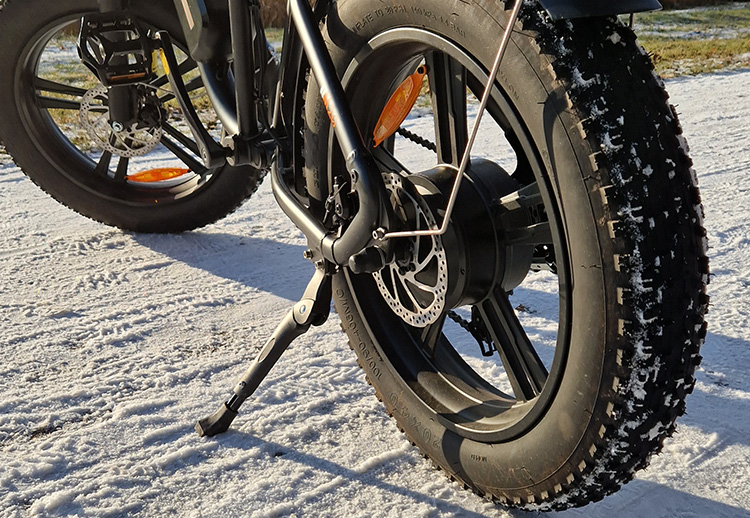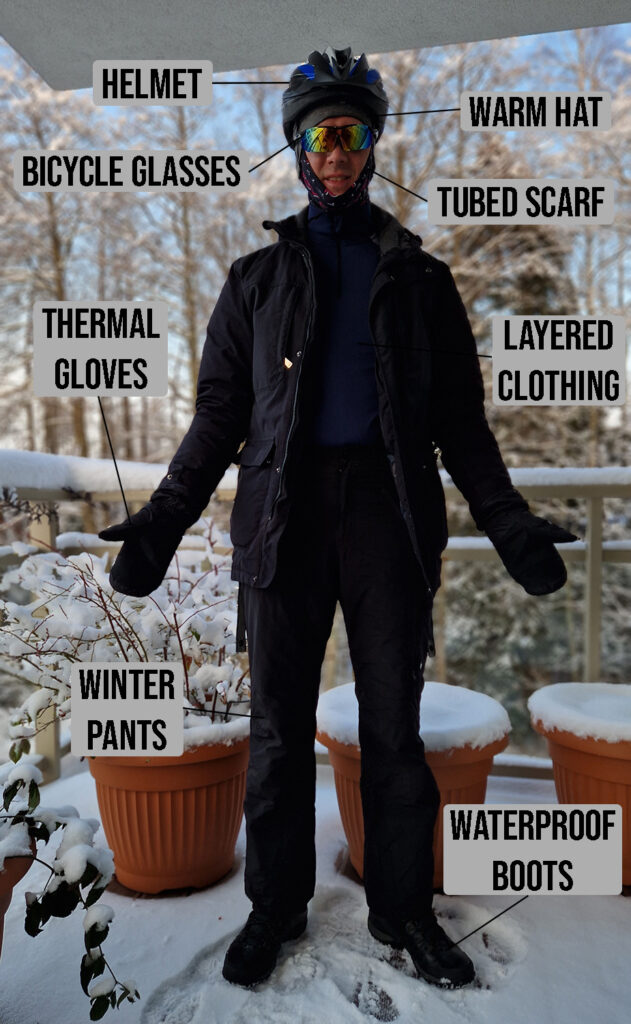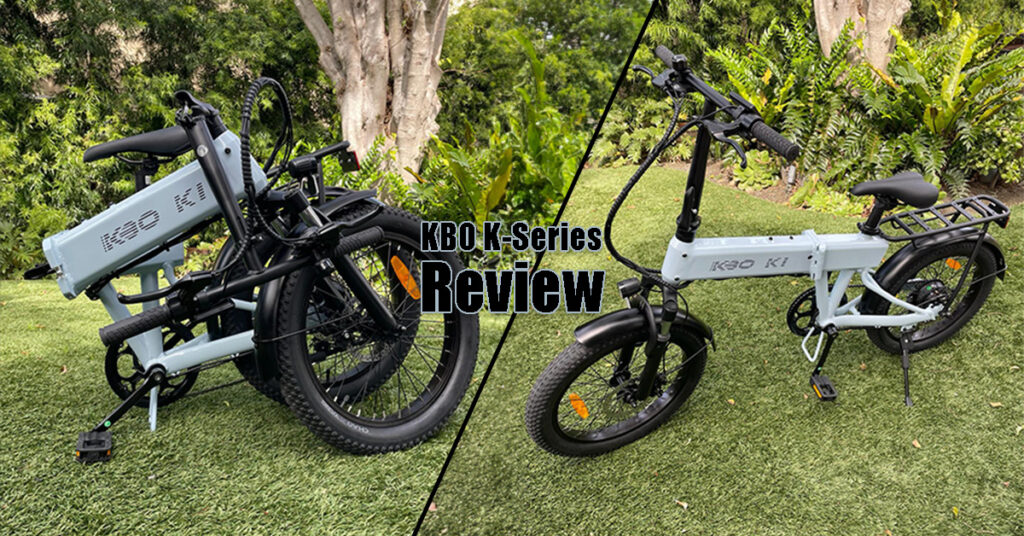As the temperature drops and the landscape transforms into a sparkling white canvas, the allure of winter e-biking beckons the adventurous at heart.
While some might suggest it’s a pursuit best left for warmer days, we’re here to dispel that myth.
Winter e-biking, when approached with the right preparation and mindset, is an exhilarating experience that can redefine your relationship with both cycling and the season.
In this article, we’ll guide you through everything you need to know about riding your electric bike in the snow and cold, from winterizing your bike to gearing up for the chill.
So, bundle up, prepare your e-bike, and get ready to explore the wonders of winter cycling.
Electric Wheelers is reader-supported. Although we independently research and test products, we may receive a commission on purchases made from our chosen links. Read more…
Challenges of Winter E-Biking
Riding an electric bike in winter brings unique challenges, both for the bike’s mechanics and the rider’s navigation through snow and ice.
As temperatures drop, the very heart of your e-bike, the battery, begins to show signs of strain. Cold weather is known to affect the chemical processes inside the battery, leading to a reduced ability to hold charge. This phenomenon can significantly cut down your e-bike’s range, demanding more frequent recharges or the need for a backup battery.
The interaction between your e-bike’s tires and the winter terrain is another critical factor. Snow and ice drastically reduce traction, making your regular tires less effective. This lack of grip not only makes it harder to pedal but also increases the risk of slips and falls.
The response of your brakes also changes in the cold. Hydraulic brakes, in particular, may become less responsive as the fluid inside them thickens, and brake cables can stiffen, both of which can affect braking efficiency.
Moreover, the cold weather can impact the responsiveness of your e-bike’s LCD displays and controls. Displays may become sluggish or less responsive in extreme cold, which can hinder monitoring your speed and battery life.
Lastly, winter roads often come with their own set of challenges, including salt and grit. These elements, while helpful for melting snow and ice, can be corrosive to your e-bike’s components. Parts such as the chain and gears are particularly vulnerable and can suffer from accelerated wear if not properly cared for.
How to Winterize Your E-Bike?
Protecting the Heart of Your Electric Bike
The battery is the powerhouse of your electric bike, and special care is needed during winter to ensure its longevity and performance.
- Keep it Warm: As cold temperatures can sap the battery’s life, it’s crucial to keep it warm. This doesn’t mean overheating it but rather shielding it from extreme cold. You can use a thermal cover or simply store the battery indoors when not in use. For more detailed strategies on keeping the battery warm, check our dedicated article here.
- Avoid Full Discharge: In winter, aim to keep your battery charged above 20%. Cold weather can exacerbate the effects of a low charge, potentially leading to a shortened battery lifespan.
- Regular Charging: Even if you’re not using your e-bike as frequently, keep the battery charged. A battery left discharged for long periods, especially in the cold, can suffer from reduced capacity.
- Gentle Charging: Charge the battery slowly and gently, preferably in a warm environment. You should never charge the battery if the temperature is below 32ºF or 0ºC. Fast charging in cold conditions can stress the battery cells.
- Storage Location: Store your e-bike and its battery in a dry, insulated space. Avoid leaving it in freezing temperatures for extended periods, as this can cause irreversible damage to the battery cells.
Choosing the Right Tires for Winter Adventures

When winter arrives, transforming streets into snowy and icy terrains, the right tires on your e-bike can be the difference between a smooth ride and a slippery ordeal. Here’s how to adapt your tires for the season:
- Embrace Fat Tires: If you’re fortunate to have a fat bike with 4-inch wide tires, you’re already a step ahead. These tires offer exceptional traction in snow. For riding in loose snow conditions, fat tires are highly recommended. Their increased air volume allows for running at lower pressures, which is beneficial for loose surfaces like snow, sand, and dirt.
- Tire Pressure Experimentation: The perfect tire pressure for winter conditions varies. Generally, lower pressure is better for improved grip. To optimize their grip, reduce the air pressure to around 8 or 10 psi, or even lower if you’re lighter. The reduced pressure increases the contact area with the snow, enhancing stability. However, this depends on your weight and the specific snow conditions. Regularly adjust and experiment to find the sweet spot that offers the best traction for your ride.
- Studded Snow Tires: In regions where ice is more common than snow, studded snow tires for bicycles can be a game-changer. These tires come with metal studs that bite into the ice, providing significantly better traction. They won’t match the grip of dry pavement, but they offer a considerable improvement over regular tires. Always remember to ride cautiously.
- Understanding Different Tire Types: Standard mountain bike knobby tires or city tires with light treads may struggle with traction in the snow. Snow tends to pack into the treads, reducing their grip. Lowering the tire pressure can help, but if you’re riding an e-bike with thin road tires, it may be safer to avoid snowy rides.
- Regular Tire Checks: Winter conditions can be harsh on tires. Regularly inspect them for wear and tear, and keep an eye out for any damage caused by the cold and abrasive surfaces.
Protect Your E-Bike from Salt and Moisture
Winter riding means exposing your e-bike to salt and moisture, which can lead to corrosion. Here’s how to protect your beloved ride from these elements:
- Regular Cleaning: After every winter ride, especially on salted roads, give your e-bike a thorough cleaning. Use a gentle stream of water to wash away salt and mud. Avoid high-pressure hoses, as they can force water into the bearings and electrical components.
- Use a Protective Spray: Applying a bike-specific protective spray can create a barrier against moisture and salt. Look for sprays designed for bicycles and apply them to the metal parts of your bike, especially the chain, gears, and any exposed metal surfaces. Avoid spraying on brake rotors and pads to maintain effective braking.
- Lubricate Moving Parts: Regular lubrication of the chain and gears is crucial in winter. Use a wet lubricant designed for damp or winter conditions as it adheres better and provides longer-lasting protection against moisture and salt.
- Dry Your Bike Properly: After cleaning, make sure your e-bike is completely dry before storing it. Use a clean cloth to wipe down all surfaces. Pay special attention to the chain, derailleurs, and any areas where water might collect.
- Cover Exposed Connectors: If possible, cover exposed electrical connectors with a waterproof material or use dielectric grease. This helps prevent moisture from causing electrical faults or corrosion.
- Avoid Deep Puddles and Snowbanks: When riding, try to avoid deep puddles or snowbanks where water and salt can splash onto your bike’s components. Stick to cleared paths as much as possible.
Gearing Up for Cold Weather Riding

Riding an e-bike in winter can be an exhilarating experience, but it also requires appropriate gear to stay warm and safe. Here’s how you can gear up for cold-weather riding:
- Layered Clothing: Dress in layers to manage body temperature effectively. Start with a moisture-wicking base layer to keep sweat away from your skin. Add an insulating middle layer, like fleece, for warmth. Top it off with a windproof and waterproof outer layer to protect against the elements.
- Thermal Gloves: Your hands are crucial for controlling your e-bike, so keep them warm with insulated, waterproof gloves. Gloves designed for winter cycling or even skiing can offer the dexterity and warmth you need. Or you can consider special handlebar mitts by Rad Power Bikes.
- Winter Cycling Shoes or Boots: Cold feet can make a winter ride miserable. Invest in insulated, waterproof cycling shoes or boots. For extreme cold, consider shoe covers or winter-specific cycling shoes that provide extra warmth and protection. Also, I suggest wearing thermal socks designed for outdoor activities. Wool or wool-blend socks are excellent for keeping your feet warm and dry.
- Head and Ear Protection: A significant amount of body heat is lost through the head, so wear a thermal cap, tube scarf or balaclava under your helmet. Ensure it covers your ears, which are particularly vulnerable to the cold.
- Clear Vision: Snow and glare can impair vision. Wear clear or lightly tinted glasses or goggles to protect your eyes from the glare, wind, and any flying debris.
- High-Visibility Clothing: Winter days are shorter and often darker. Wear high-visibility clothing with reflective elements to ensure you’re seen by motorists and other cyclists.
- Hydration and Nutrition: Cold weather can be deceiving in terms of hydration needs. Carry a thermos with a warm drink and energy-rich snacks to maintain your energy levels during longer rides.
- Skin Protection: Use a high-quality moisturizer or balm on exposed skin to protect against the cold and wind. Don’t forget sunscreen on sunny days, as snow can reflect UV rays.
- Hand and Foot Warmers: For extra chilly days, consider using hand and foot warmers inside your gloves and shoes for additional warmth.
Choosing a Proper Helmet for Winter Riding
When venturing into the frosty world of winter e-biking, your first line of defense should be a reliable helmet. While most cycling helmets provide basic protection, the ideal choice for winter is one that offers extensive coverage.
This is where considering full-face biking helmets, or even motorcycle helmets, can be a wise decision. These helmets not only safeguard your head but also shield your face, playing a dual role in safety and warmth.
In winter conditions, the likelihood of slipping and falling increases significantly, regardless of the type of snow or the e-bike you ride.
Remember, snow is essentially a prettier version of ice, and it’s common for a treacherous layer of ice to form underneath the snow on paved paths. This hidden hazard can lead to unexpected crashes. In such scenarios, a sturdy helmet isn’t just an accessory; it’s an essential gear that protects your most vital asset – your head.
Therefore, as you dress to brave the cold, prioritize your helmet. It should provide robust protection while also fitting comfortably. A helmet that covers more area not only increases safety but also adds an extra layer of warmth, making your winter e-bike journey both secure and enjoyable.
If you’re wearing a hat or balaclava under your helmet, adjust the fit to accommodate the extra layer. Your helmet should still sit snugly and securely on your head.
Riding Tips for Winter Terrain
Navigating the winter landscape on an e-bike presents unique challenges. The key to a safe and enjoyable ride lies in adapting your techniques to handle the slippery terrain and the cold efficiently.
- Maintaining Balance and Traction: The trick to maintaining balance on snow and ice is to keep your movements smooth and gradual. Avoid sudden turns or jerky movements. Lowering your center of gravity by slightly crouching can also enhance stability. Avoid braking or speeding up while in the middle of a turn. Brake the momentum well before the maneuver so you don’t have to do it in the corner.
- Ride Slower: Snow and ice drastically reduce traction, making it easier to lose control and increasing the risk of accidents. By slowing down, you give yourself more time to react to slippery surfaces and unexpected obstacles hidden beneath the snow. It also lessens the impact force in case of a slip, reducing the potential for injury.
- Adjusting Speed and Braking: Slowing down is crucial on icy surfaces. Give yourself plenty of time and space to stop, as braking distances can significantly increase on slippery terrain. Use both brakes gently and evenly to avoid skidding. If you start to slide, ease off the brakes until you regain traction, then brake again gently.
- Efficient Pedaling and Battery Usage: Cold weather can sap your e-bike’s battery faster than usual. To manage this, pedal more efficiently by maintaining a steady cadence and using lower gears. This approach conserves battery power and reduces the physical strain on you.
- Understanding Winter Limitations: Be aware that your e-bike’s performance may change in winter conditions. The battery range may decrease, and the motor may not respond as quickly as it does in warmer weather. Plan shorter routes or carry a spare battery if necessary. Also, consider the reduced daylight hours and plan your trips accordingly.
In the following video, I share my personal experience of riding an electric bike in winter and show how I do it.
Final Words
Riding an electric bike during the winter months is not just feasible; it can be a uniquely enjoyable experience. With the right preparation and techniques, you can safely navigate the challenges of cold, snow, and ice.
Remember, the key to a successful winter ride lies in winterizing your e-bike, dressing appropriately for the cold, and adjusting your riding style to the conditions.
So, gear up, prepare your e-bike, and enjoy the ride. With the right approach, winter might just become your favorite e-biking season!

The founder and the editor-in-chief of the Electric Wheelers blog. With a previous background in IT, sales, and video editing, he has now established himself as a micromobility expert.
He bought his first e-scooter over 5 years ago and since then has owned dozens of e-scooters and e-bikes. His deep understanding of the technical aspects, coupled with a keen eye for market trends, enables him to provide insightful and reliable content.
His commitment to promoting sustainable and efficient urban mobility solutions has made him a respected voice in the community of eco-friendly transportation enthusiasts.




